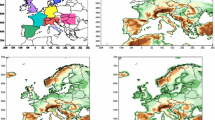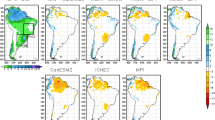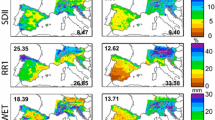Abstract
This paper investigates the effect of a Bayesian Model Averaging (BMA) method on simulated precipitation over the Columbia River Basin using two statistically downscaled climate datasets, i.e., Bias-Correction Spatial Disaggregation (BCSD) and Multivariate Adaptive Constructed Analogs (MACA). To this end daily observed and simulated precipitation are used to calculate different indices focusing solely on seasonality, event-timing, and variability in timing (persistence) of the precipitation. The climate model weights are estimated for each cell (6 × 6 km) of the Columbia River Basin using daily time series for the historical period 1970–1999 from the ten Global Climate Models (GCMs) participating to the Coupled Model Intercomparison Project platform, Phase 5. The results show that BMA results in more than 15 % improvement/reduction in mean absolute error as compared to the individual GCMs. The improvement is, in general, higher for the MACA models than for the BCSD models. The results of variability in precipitation timing show that extreme precipitation events are mostly not persistent (i.e., occurring in different periods throughout the year), i.e., more than 75 % of the grid cells with an elevation above 900 m indicate persistence values less than 0.2 whereas nearly 70 % of the high elevation cells indicate such low persistence. Further we find that the variability in persistence is higher in high elevation cells than those with low elevation. The picture is different for MACA ensembles as the simulated persistence of extreme precipitation events is higher than that for the observed and BCSD datasets.







Similar content being viewed by others
References
Abatzoglou JT (2013) Development of gridded surface meteorological data for ecological applications and modelling. Int J Climatol 33:121–131. doi:10.1002/joc.3413
Abatzoglou JT, Brown TJ (2012) A comparison of statistical downscaling methods suited for wildfire applications. Int J Climatol 32:772–780. doi:10.1002/joc.2312
Ahmadalipour A, Rana A, Moradkhani H, AS (2015) Statistical multi-criteria analysis of CMIP5 GCMs for climate change impact analysis over the Columbia River Basin. (submitted)
Box GEP, Cox DR (1964) An analysis of transformations. J R Stat Soc Ser B 26:211–252. doi:10.2307/2984418
Burn DH (1997) Catchment similarity for regional flood frequency analysis using seasonality measures. J Hydrol 202:212–230. doi:10.1016/S0022-1694(97)00068-1
CCRH (2015) Columbia River. http://www.ccrh.org/river/history.htm. Accessed 15 Jan 2015
Daly C, Halbleib M, Smith JI et al (2008) Physiographically sensitive mapping of climatological temperature and precipitation across the conterminous United States. Int J Climatol 28:2031–2064. doi:10.1002/joc.1688
Duan Q, Ajami NK, Gao X, Sorooshian S (2007) Multi-model ensemble hydrologic prediction using Bayesian model averaging. Adv Water Resour 30:1371–1386. doi:10.1016/j.advwatres.2006.11.014
Elison Timm O, Giambelluca TW, Diaz HF (2014) Statistical downscaling of rainfall changes in Hawai‘i based on the CMIP5 global model projections. J Geophys Res Atmos. doi:10.1002/2014JD022059
Feng X, Porporato A, Rodriguez-Iturbe I (2013) Changes in rainfall seasonality in the tropics. Nat Clim Chang 3:811–815. doi: 10.1038/nclimate1907 http://www.nature.com/nclimate/journal/v3/n9/abs/nclimate1907.html#supplementary-information
Giorgi F (2003) Probability of regional climate change based on the reliability ensemble averaging (REA) method. Geophys Res Lett 30:1629. doi:10.1029/2003GL017130
Giorgi F, Mearns LO (2002) Calculation of average, uncertainty range, and reliability of regional climate changes from AOGCM simulations via the “reliability ensemble averaging” (REA) method. J Clim 15:1141–1158. doi:10.1175/1520-0442(2002)015<1141:COAURA>2.0.CO;2
Iizumi T, Nishimori M, Dairaku K et al (2011) Evaluation and intercomparison of downscaled daily precipitation indices over Japan in present-day climate: strengths and weaknesses of dynamical and bias correction-type statistical downscaling methods. J Geophys Res 116:D01111. doi:10.1029/2010JD014513
Li W, Fu R, Dickinson RE (2006) Rainfall and its seasonality over the Amazon in the 21st century as assessed by the coupled models for the IPCC AR4. J Geophys Res Atmos 111:D02111. doi:10.1029/2005JD006355
Liu Z, Mehran A, Phillips TJ, AghaKouchak A (2014) Seasonal and regional biases in CMIP5 precipitation simulations. Clim Res 60:35–50
Livneh B, Rosenberg EA, Lin C et al (2013) A long-term hydrologically based dataset of land surface fluxes and states for the conterminous United States: update and extensions*
Lute AC, Abatzoglou JT, Hegewisch KC (2015) Projected changes in snowfall extremes and interannual variability of snowfall in the western U.S. Water Resour Res. doi:10.1002/2014WR016267
Madadgar S, Moradkhani H (2014) Improved Bayesian multimodeling: Integration of copulas and Bayesian model averaging. Water Resour Res. doi:10.1002/2014WR015965
Matheussen B, Kirschbaum RL, Goodman IA et al (2000) Effects of land cover change on streamflow in the interior Columbia River Basin (USA and Canada). Hydrol Process 14:867–885. doi:10.1002/(SICI)1099-1085(20000415)14:5<867::AID-HYP975>3.0.CO;2-5
Maurer EP, Wood AW, Adam JC et al (2002) A long-term hydrologically based dataset of land surface fluxes and states for the conterminous United States*. J Clim 15:3237–3251. doi:10.1175/1520-0442(2002)015<3237:ALTHBD>2.0.CO;2
Najafi MR, Moradkhani H (2014) A hierarchical Bayesian approach for the analysis of climate change impact on runoff extremes. Hydrol Process 28:6292–6308. doi:10.1002/hyp.10113
Najafi M, Moradkhani H (2015a) Ensemble combination of seasonal streamflow forecasts. J Hydrol Eng 4015043. doi: 10.1061/(ASCE)HE.1943-5584.0001250
Najafi MR, Moradkhani H (2015b) Multi-model ensemble analysis of runoff extremes for climate change impact assessments. J Hydrol 525:352–361. doi:10.1016/j.jhydrol.2015.03.045
Najafi MR, Moradkhani H, Piechota TC (2012) Ensemble streamflow prediction: climate signal weighting methods vs climate forecast system reanalysis. J Hydrol 442–443:105–116. doi:10.1016/j.jhydrol.2012.04.003
Pal I, Anderson BT, Salvucci GD, Gianotti DJ (2013) Shifting seasonality and increasing frequency of precipitation in wet and dry seasons across the U.S. Geophys Res Lett 40:4030–4035. doi:10.1002/grl.50760
Parajka J, Kohnová S, Merz R et al (2009a) Comparative analysis of the seasonality of hydrological characteristics in Slovakia and Austria. Hydrol Sci J 54:456–473
Parajka J, Kohnová S, Merz R et al (2009b) Comparative analysis of the seasonality of hydrological characteristics in Slovakia and Austria/Analyse comparative de la saisonnalité de caractéristiques hydrologiques en Slovaquie et en Autriche. Hydrol Sci J 54:456–473
Pascale S, Lucarini V, Feng X et al (2014) Analysis of rainfall seasonality from observations and climate models. Clim Dyn 1–21. doi: 10.1007/s00382-014-2278-2
Pryor SC, Schoof JT (2008) Changes in the seasonality of precipitation over the contiguous USA. J Geophys Res 113:D21108. doi:10.1029/2008jd010251, Artn D21108
Raftery AE, Gneiting T, Balabdaoui F, Polakowski M (2005) Using Bayesian model averaging to calibrate forecast ensembles. Mon Weather Rev 133:1155–1174. doi:10.1175/MWR2906.1
Rajah K, O’Leary T, Turner A et al (2014) Changes to the temporal distribution of daily precipitation. Geophys Res Lett. doi:10.1002/2014GL062156
Rana A, Moradkhani H (2015) Spatial, temporal and frequency based climate change assessment in Columbia River Basin using multi downscaled-Scenarios. Clim Dyn. doi:10.1007/s00382-015-2857-x
Safeeq M, Grant GE, Lewis SL et al (2014) A hydrogeologic framework for characterizing summer streamflow sensitivity to climate warming in the Pacific Northwest, USA. Hydrol Earth Syst Sci 18:3693–3710. doi:10.5194/hess-18-3693-2014
Sumner G, Homar V, Ramis C (2001) Precipitation seasonality in eastern and southern coastal Spain. Int J Climatol 21:219–247. doi:10.1002/joc.600
Sun S, Wang G (2014) Climate variability attributable to terrestrial and oceanic forcing in the NCAR CAM3-CLM3 models. Clim Dyn 42:2067–2078. doi:10.1007/s00382-013-1913-7
Tebaldi C, Knutti R (2007) The use of the multi-model ensemble in probabilistic climate projections. Philos Transact A Math Phys Eng Sci 365:2053–2075. doi:10.1098/rsta.2007.2076
Walsh RPD, Lawler DM (1981) Rainfall seasonality: description, spatial patterns and change through time. Weather 36:201–208. doi:10.1002/j.1477-8696.1981.tb05400.x
Weigel AP, Knutti R, Liniger MA, Appenzeller C (2010) Risks of model weighting in multimodel climate projections. J Clim 23:4175–4191. doi:10.1175/2010JCLI3594.1
Wood AW, Leung LR, Sridhar V, Lettenmaier DP (2004) Hydrologic implications of dynamical and statistical approaches to downscaling climate model outputs. Clim Chang 62:189–216. doi:10.1023/B:CLIM.0000013685.99609.9e
Acknowledgments
Partial financial support for this study was provided by the DOE-BPA (cooperative agreement 00063182) and also Institute for Sustainable Solution at Portland State University.
Author information
Authors and Affiliations
Corresponding author
Rights and permissions
About this article
Cite this article
Demirel, M.C., Moradkhani, H. Assessing the impact of CMIP5 climate multi-modeling on estimating the precipitation seasonality and timing. Climatic Change 135, 357–372 (2016). https://doi.org/10.1007/s10584-015-1559-z
Received:
Accepted:
Published:
Issue Date:
DOI: https://doi.org/10.1007/s10584-015-1559-z




